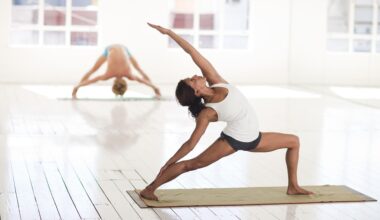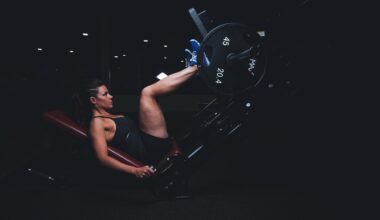Combining Yoga and Inline Skating for Flexibility and Strength
Inline skating has gained immense popularity as a fun and engaging sport. While developing skills in skating, many overlook the physical and mental conditioning that enhances performance. One powerful practice that can fundamentally support inline skating is yoga. Combining yoga with inline skating cultivates not only strength but also flexibility. These two components are essential for maintaining balance and agility on skates. Yoga emphasizes postures and breathing techniques that enhance range of motion and muscle relaxation. Practitioners of yoga often develop better body awareness, which translates into improved skating technique. This increased awareness helps in executing complex movements. Many inline skaters experience injuries due to limited flexibility, and incorporating yoga can significantly reduce these risks. Enthusiasts find that regular yoga sessions enable a deeper understanding of their body mechanics. Therefore, aspiring inline skaters should consider adding yoga as a vital component of their training regimen. This collaboration helps skaters excel, enhancing performance, safety, and enjoyment of inline skating. Strengthening both mind and body through yoga plays a crucial role in achieving notable progress in the sport, fostering personal growth along the journey.
The benefits of yoga in supporting skateboarding and inline skating extend beyond physical advantages. Mindfulness is a core component of yoga, encouraging practitioners to be present in each moment. This practice becomes instrumental as it enhances focus and concentration during skating sessions. Skaters often encounter distractions, whether from the skate environment or personal thoughts. By applying yoga principles, skaters can learn to manage stress and maintain a higher level of concentration. Enhanced mental clarity contributes to improved decision-making while skating. Furthermore, yoga promotes a strong mind-body connection, which helps skaters react swiftly to different situations while on their skates. Breathing techniques learned through yoga boost lung capacity, which is incredibly advantageous during extensive skating workouts. As skaters fine-tune their breath, they also develop a more efficient cardiovascular system. Students of yoga often experience greater stamina during long skate sessions or competitions. Overall, the fusion of yoga with inline skating cultivates a holistic growth experience, resulting in not only a more skilled skater but also a more grounded individual. Taking mindfulness practices onto the skating path can create a unique synergy that enhances every glide and trick performed.
Yoga Poses Ideal for Inline Skaters
Several specific yoga poses can significantly enhance flexibility and strength for inline skaters. Firstly, the downward-facing dog is an excellent pose for stretching the hamstrings and calves, essential areas for skaters. This pose helps alleviate tension and improves overall leg strength. Secondly, the warrior pose focuses on building strength in the legs while enhancing balance. Practicing this pose allows skaters to develop the core stability necessary for various skating activities. Additionally, the pigeon pose effectively opens up the hips, promoting greater flexibility. Skaters often find that tight hip muscles can impede movement, making pigeon pose an essential addition to their routines. Another beneficial pose is the triangle pose, which strengthens the legs while enhancing lateral flexibility. This is especially important when executing turns and transitions on skates. Lastly, incorporating balancing poses like the tree pose into training helps skaters improve their balance, which is crucial for maintaining stability on skates. Incorporating these yoga poses into regular training can yield remarkable improvements in both flexibility and strength, aiding skate performance while reducing the risk of injuries.
The combination of yoga and inline skating is not limited to physical practices alone. Nutrition plays a significant role as well. Proper nutritional support enhances a skater’s energy levels, recovery, and overall health. Consuming a balanced diet rich in vitamins, minerals, and macronutrients is essential for optimal performance. Inline skaters can benefit from meals that include lean proteins, whole grains, fruits, and vegetables. Foods like bananas and almond butter provide quick energy, promoting endurance during lengthy skating sessions. Hydration is equally important; skaters should aim to drink plenty of fluids to stay fully hydrated and maintain performance. The practice of yoga also highlights the importance of mindful eating, teaching individuals to connect with their hunger cues and choose nourishing foods intentionally. Skaters developing this connection often find that their body responds more positively to nutrient-dense foods. By consciously fueling the body, inline skaters can optimize their performance and recovery times. Integrating healthy eating habits along with yoga training creates a multifaceted approach to skateboarding. This combination helps skaters tackle challenges efficiently, allowing them to truly enjoy their skating journey.
Creating a Balanced Training Schedule
To maximize the benefits of combining yoga with inline skating, creating a balanced training schedule is essential. Dedicating specific days for yoga practice helps skaters maintain a consistent approach to their training. For example, skaters may choose to practice yoga three times a week, focusing on flexibility, strength, and recovery. On alternate days, they can engage in inline skating, working on their skating skills and endurance. It is vital to ensure that skaters allow for adequate rest days between challenging sessions to promote muscle recovery. Rest and recovery are crucial components that enable muscles to heal and develop. Incorporating cross-training activities such as cycling, swimming, or strength training can further enhance their fitness routine. These activities contribute to overall strength and endurance, which is beneficial for long skating sessions. Sticking to a schedule helps establish routine and discipline, essential traits in both yoga and skating practices. By embracing a balanced training schedule that includes dedicated time for yoga as well as inline skating, individuals can maximize their progress and enjoyment in both disciplines, leading to greater overall success.
Moreover, engaging with a community can foster significant motivation and support as skaters integrate yoga into their training. Joining local classes or online forums provides a sense of belonging to individuals who share similar interests. Organizations often organize workshops or events that focus on the synergy between yoga and inline skating. Participating in such events presents valuable opportunities for networking, gaining knowledge, and sharing experiences with fellow skaters. These social connections can create a positive atmosphere that inspires practice dedication. Use social media platforms to follow yoga instructors or professional inline skaters who share tips and routines. Visual inspiration can further drive one’s commitment to both activities. Skaters can consider inviting friends to join their yoga practices, creating group settings that make training enjoyable and engaging. Collaborating in practice environments allows individuals to explore movements more dynamically while encouraging one another. Cultivating a community ultimately enriches the overall skating journey. Breaking barriers and overcoming challenges becomes a shared celebration, empowering skaters to push through limitations and grow within their abilities.
Finally, as athletes blend yoga with inline skating, their journey becomes a pathway toward excellence in both sports. Continuous practice fosters resilience, focus, and a deeper understanding of one’s body. Both fields emphasize discipline, whether mastering new yoga poses or perfecting skating techniques. The progress achieved from practicing yoga translates into a sustained commitment toward inline skating. This harmonious relationship between the two disciplines aids physical, mental, and emotional growth. It becomes a holistic approach to skating rather than merely confronting each practice type separately. Celebrating milestones, big or small, serves as motivation to continue the journey. Documenting progress through journaling or sharing experiences fosters reflection on personal development. With persistence, inline skaters can achieve newfound heights in their skills, revealing the extraordinary potential within. Coupled with the unity of community engagement, a continuous flow of creativity emerges. This synergy allows skaters to freely express themselves, ultimately generating a fulfilling experience on and off their skates. As they unite these practices, practitioners will find themselves not only improving in skill but also in overall joy while skating.
Conclusion
The combination of yoga and inline skating is a transformative experience for those passionate about either discipline or both. By embracing practices that improve flexibility and strength, inline skaters can experience enhanced skill levels while minimizing injuries. The mental clarity gained from yoga complements the agility required in skating, making it a dynamic duo that benefits practitioners. Moreover, incorporating sound nutrition alongside a balanced training schedule ensures that the body receives the necessary support to thrive. Building community connections enriches the journey, allowing for shared growth and motivation through both practices. Taking the leap to integrate yoga with inline skating fosters a profound appreciation for physical movement, encouraging happiness. Whether aspiring to become a better skater or simply seeking a fulfilling challenge, the blend of both disciplines opens numerous doors to success and personal achievement. Those who dare to explore this chic union will promote an active lifestyle while celebrating flexibility and strength simultaneously. Committing to this incredible journey ultimately transforms skaters into stronger, more resilient individuals, seeking greater potential within themselves. The impact of this combination is lasting, elevating the overall experience of life on skates.


